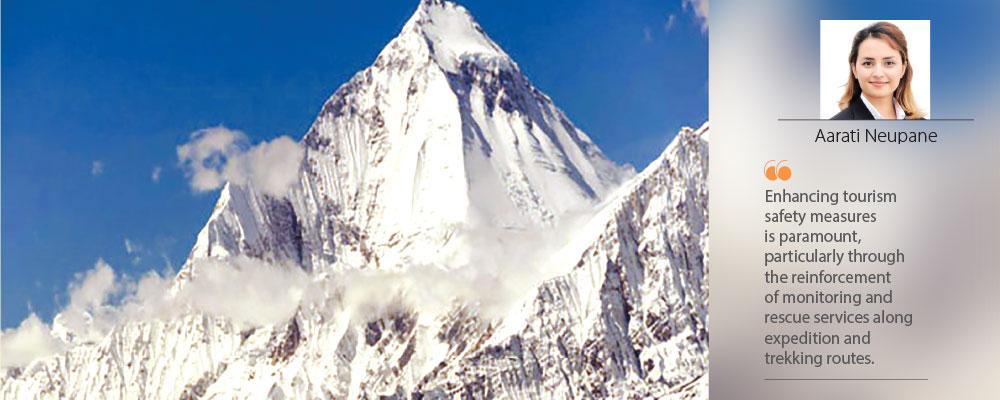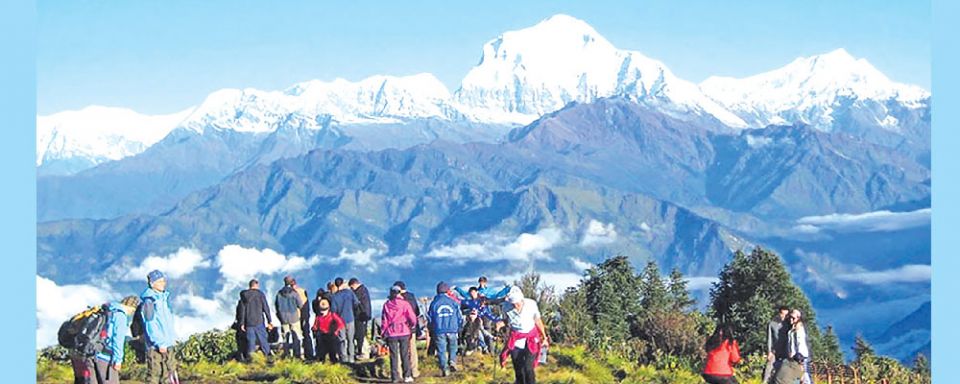
Mountain tourism is a significant sector of the global economy, constituting 15-20 per cent of tourism worldwide, with annual revenues ranging from 70 to 90 billion US dollars. It ranks second only to coastal tourism in popularity, driven by improved transport, rising incomes, and growing interest in outdoor activities.
Defined by the UN as activities in mountainous areas with unique landscapes, biodiversity, and local culture, mountain tourism thrives in destinations like Nepal's Himalayas. Here, visitors are drawn to activities like trekking and climbing amid stunning natural beauty, diverse flora and fauna, and rich cultural experiences, making Nepal a uniquely appealing destination.
Himalayan giants
Nepal's tourism, rooted in mountain exploration since opening to visitors in 1949, underscores its identity as a Himalayan nation. The country's landscapes, with mountains and the Himalayas covering 83 per cent of its 147,181 sq. km. area, boast over 300 peaks exceeding 7,000 metres, including eight of the world's fourteen 8,000-metre peaks like Everest and Annapurna. With 1,792 peaks overall, 1310 stand above 6,000 metres, attracting global adventurers and trekkers to iconic routes such as Everest Base Camp and Annapurna Circuit. In 2023, Nepal welcomed 1,014,882 tourists, 15% of whom were drawn to trekking and mountaineering, generating significant revenue from expeditions to peaks like Everest, Manaslu, and Lhotse.
In 2023, Nepal welcomed a total of 1,014,882 tourists, among whom about 154,262, i.e. 15 per cent of the tourists, were drawn to the country for trekking and mountaineering (Ministry of Culture, Tourism, and Civil Aviation). According to Tourism Statistics 2023, the three mountains that made the highest royalty payments were Mount Everest (Sagarmatha), with 47 expedition teams generating a revenue of USD 5,086,020; Mount Manaslu, with 31 expedition teams generating a revenue of USD 298,350; and Mount Lhotse, with 17 teams generating a revenue of USD 269,876. The total number of expedition permits soared to 2253 teams, with climbers predominantly originating from the USA, China, France, the UK, India, Russia, Germany, and Japan.
Mountain tourism
Nepal´s constitution prioritises eco-friendly tourism as vital for the national economy. Tourism Policy 2065 aims to establish Nepal as an attractive, safe, exciting, and unique tourist destination, emphasising the formulation and execution of master plans for tourism industry development and integrating regional development concepts into periodic plans and annual programs. However, the National Tourism Strategy Plan 2014–2023 analysis shows that currently, about 35 per cent of the policy is in effect, mostly partially, with only a small portion fully implemented.
The government introduced the Tourism Decade 2023–2032, envisioning the revitalization of the country's tourism industry, blown by the COVID-19 pandemic. Moreover, the plan aims to elevate the contribution to the national GDP to 10 percent by attracting 3.5 million tourists in the next decade, excluding Indian and overland visitors, boosting tourist spending to $125 per day, and generating 1 million direct jobs in the tourism sector. However, specific aspects of the policy, such as rural tourism and domestic tourism, exhibit notable deficiencies in terms of implementation. Although Vision 2020 represented a collaborative effort between the government and the private sector to enhance the tourism sector, the absence of concrete plans to realise it resulted in implementation hurdles.

According to the Department of Tourism, the registered numbers rose to 4845 travel agencies, 3191 trekking agencies, 112 tourist transportation services, 5123 tour guides, and 26292 trekking guides by the end of 2080/81. Similarly, as stated by the Civil Aviation Authority, only two Nepali airlines and 20 international airlines are facilitating transportation. Moreover, the country has bilateral civil aviation agreements with 41 countries. Among the 53 airports in Nepal, 32 are currently operational, while construction is underway for one domestic and three international airports. Regrettably, 21 airports remain non-functional at present.
Challenges
According to the Department of Tourism, the Tourist Police has reported a total of 345 lost or missing tourists, 82 stolen or stolen, 33 fraudulent or cheated, 13 robbed, two pickpocketed, and 28 harassed at the end of the fiscal year 2079–80 B.S. An investigation conducted by the British Broadcasting Corporation (BBC) in 2015 revealed that over 200 individuals were deceased on the slopes of Mt. Everest. Each year, an average of six fatalities occur during the ascent and descent of the peak. Moreover, 2023 marked a grim milestone, with the highest recorded death toll of 13 climbers and an additional five reported missing or presumed dead.
Over the past 25 years, the South Col Glacier, positioned between Mount Everest and Lhotse at approximately 7,906 metres (25,938 feet) above sea level, has experienced a reduction in thickness exceeding 180 feet (54 meters). The issues of human excrement in mountainous regions have been exacerbated due to ineffective solutions. Leaking of human waste into base camps and settlements has contaminated the environment, leading to intestinal and respiratory infections, waterborne diseases like cholera, and hepatitis among residents and climbers.
Mainstreaming
Mountain tourism, a significant foreign exchange earner for Nepal, contributed $844 million in 2023. By mainstreaming mountain tourism, the country can unlock its potential as a key driver of socioeconomic development. It is essential to enhance accessibility to mountain regions through infrastructure development involving transportation, accommodation, and communication networks. The tourism offerings should be diversified through investigative research on new tourism products. The lesser-known trekking destinations should be promoted and advertised to expand beyond the traditional trekking routes, such as Annapurna Circuit and Everest Base Camp.
Potential global tourists should be reached through robust digital marketing strategies showcasing international tourism offerings leveraging social media. Collaboration and cooperation with the UN World Tourism Organisation, Nepali diplomatic missions, international travel agencies, airlines, and media outlets are essential to enhancing visibility. This should be supported by streamlining the permit process, tax incentives, policies, and regulatory frameworks. The private sector's involvement in tourism entrepreneurship and partnership with the government, NGOs, and local communities leads to innovation and the fostering of tourism initiatives. Enhancing tourism safety measures is paramount, particularly through the reinforcement of monitoring and rescue services along expedition and trekking routes.










